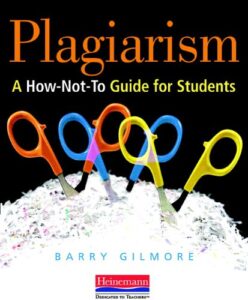Helping Students Avoid the Perils of Plagiarism
Plagiarism: A How-Not-To Guide for Students
By Barry Gilmore, Ed.D.
(Heinemann Press, 2009 – Learn more)
Reviewed by Erin Corrigan-Smith

His name alone adds a level of gravitas to any subject covered, and the reader knows they are in for a well-researched, well-written, and engaging book on a current and relevant issue in education. Plagiarism: A How-Not-To Guide for Students is just that book!

Teaching about plagiarism occurs as early as 6th grade in the ELA classroom, but students continue to plagiarize year after year, even into high school and beyond. We are beginning to see the real-world repercussions of plagiarism across social media and the internet, so this book and its many resources comes at the right time.
Written with Students in Mind
This book, originally published in 2009, is written for student consumption. It has kid-friendly language and discusses what plagiarism is and why it should be avoided. There is even a chapter called “Making It Personal: Plagiarism and the Culture of Your School” (Chapter 5) which encourages students to self-reflect on times when they have given in to the temptation to plagiarize and what they could have done differently. A section in the back of the book includes information on both MLA and APA formatting, to help students cite their work moving forward.
Heinemann has made this text affordable for all schools – a class set of 25 student texts and one teacher guide can be purchased for around $200. The only information in the text that might be outdated is the MLA and APA citing guides, but that is easily remedied with any number of other online resources. Essentially, this book set could be shared amongst a team of teachers, or even a grade level, if necessary.
What You’ll Find in the Teacher’s Version
The teacher’s version (published in 2008 as Plagiarism: Why It Happens – How to Prevent It) parallels the student edition – the two were written to complement one another. They share information and examples, but the student edition is written in a more conversational way to truly speak to the student while the teacher version includes teaching ideas and other pedagogical content.
Heinemann offers several resources for the teacher edition, such as a study guide, that can be used in the classroom to pre-assess students on their understanding of plagiarism. It’s definitely worth a teacher’s timel to review the resources online that supplement this text (podcast, website, and handouts).
There is no earth-shattering or world-changing information in this book, but it is definitely a good resource for those writing and research-heavy classes where students are more likely to try to take the “easy” way and copy and paste their “learning.”
The brevity of this book (about 100 pages) makes it an effective tool to implement in the classroom as a support to the usual texts. I found Plagiarism to be a common-sense guide that helps students understand the motivation behind plagiaristic acts and gives them the moves they need to avoid it in both academic and employment settings.
NOTE: The author of Plagiarism, Barry Gilmore, passed away in 2019.
Erin Corrigan-Smith is a secondary ELA teacher in a suburb of Atlanta. She has a B.A. and M.A. in English, and her focus of study is children’s literature. She has recently returned to school to earn an Ed.D. in Reading and Literacy. In her downtime, she enjoys going to her family’s cabin in the North Georgia mountains, with her husband and dog, to read, complete her never-ending piles of homework, and relax.































How may I get in touch with the author of this book review?
Hello- I am the author of this review. My email is erin.ggc@gmail.com. Please feel free to reach out at any time!
Erin